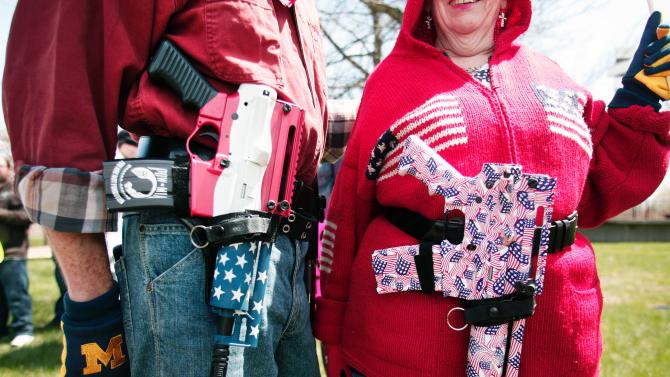
While the attention of America—and the world, for that matter—is on the demand for answers about the death of an unarmed 18-year-old in Ferguson, Mo., I wanted to take a moment to discuss another officer-involved shooting that happened just four days before Michael Brown was gunned down.
John Crawford III was shot in a Wal-Mart after police received a 911 call alerting them that a man with a rifle was walking around the store. Officers arrived on the scene and, after a brief encounter, shot the 22-year-old man, who later died of a gunshot wound to the torso. As we now know, Crawford was holding a Crosman MK-177 air pump rifle—a nonlethal replica air rifle, intended for a child—and sold at the very store where he was shot while carrying it. Much of the focus of the discussions around this case has been on this fact: Why would police shoot a man holding a child’s replica gun in the store that sold it? A fair question, to be sure, but I wish to raise another.
Ohio is an “open carry” state. So even if Crawford were carrying a real, fully loaded rifle, why would that raise any alarms? How could that possibly be a reason to kill him?
I’ll let that marinate for a second while I give you a little background on what open carry actually means. It varies from state to state, but Ohio’s open-carry laws mean an individual can possess a firearm without a permit in most public spaces (including stores) so long as it is fully visible. In fact, in Ohio, you only need a permit if you wish to conceal a handgun. That means if you want to walk around with an AK-47, AR-15 or even a Remington 870 pump-action shotgun, no problem—so long as you don’t conceal it and/or go around threatening people with it.
Which brings me back to John Crawford. He was holding a toy gun in the store that sold it, and even if he were holding an honest-to-goodness rifle loaded with real bullets, he was well within his Ohioan rights to do so. Who was he threatening? We’ve seen open-carry activists all over the country walk around in public and visit major chain stores without so much as a police scolding, let alone a confrontation with police or an actual shooting.
Here are a couple of shots of open-carry activists:

This guy looks perfectly—gulp—harmless, at least according to the officer keeping an eye on—and not shooting—him.
And how about this mother of the year, allowed to cuddle with her kid and her gun all at once?

So what was different about John Crawford? Why was he seen as a threat? Why is he dead and all these other folks are alive and well with awesome stories to share at the next parent-teacher rifle-cleaning night?
The difference is simple, and it’s the difference in almost every case of police violence perpetrated on innocent citizens. He was black. Many African Americans and Latinos alike see these open-carry folks like the ones above and think, “Hey, if white people are walking around with guns like that, maybe I need to … ” I know I have. But as soon as we think it, we scoff, laugh or smirk to ourselves because we know what the outcome would be if we expected the same treatment.
This isn’t just a what-if scenario. This is not conjecture. Consider this 2012 incident at an Ohio gas station: A white man entered a store openly carrying his weapon. Police confronted him. No weapons were drawn, and there were no commands to give up the gun, just a stern conversation. He was asked to provide identification, but he refused and was then arrested … and then released. Alive. The charges were eventually dropped, and he is now suing the police department for $3.6 million. I wish John Crawford could file a suit.
Another example: A woman was at a bus stop waiting for her child to come home from school but was approached by an officer who saw her weapon (watch the harrowing confrontation here). No yelling, no commands to get down. In fact, the officer gives her advice and even goes so far as to say he doesn’t want to dissuade her from carrying because he’s an advocate for it. She’s as healthy as she was when she got to the bus stop, free to pick up her child and return home. I wish John Crawford could have a normal day with his kids.
I chose these two examples because they took place in Riverside and Dayton, Ohio, respectively. John Crawford was killed in Beavercreek, which is a suburb of Dayton and just a few miles from Riverside.
There’s more and more evidence all the time that laws—especially the ones related to when it’s OK to have a gun and when a person deserves to be shot—don’t apply fairly when it comes to the lives of black and brown people. (For more on the history of black people in America, read this and this.)
The bottom line is that John Crawford is dead for doing nothing more than shopping in a store and minding his business. … He just happened to do it while being black. And being black in America means you are always a threat.
Whiteness gives you open carry, blackness gets you open season.















